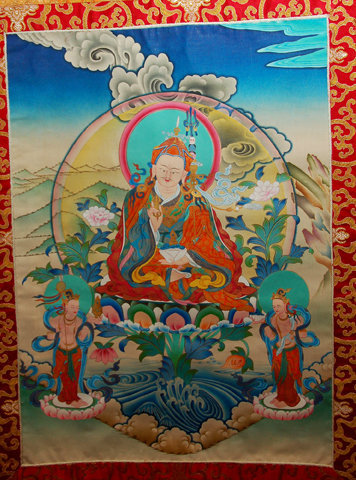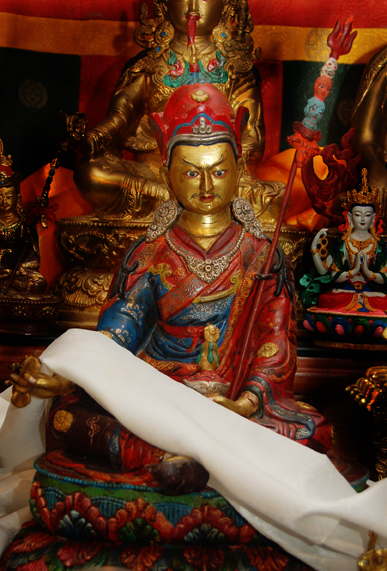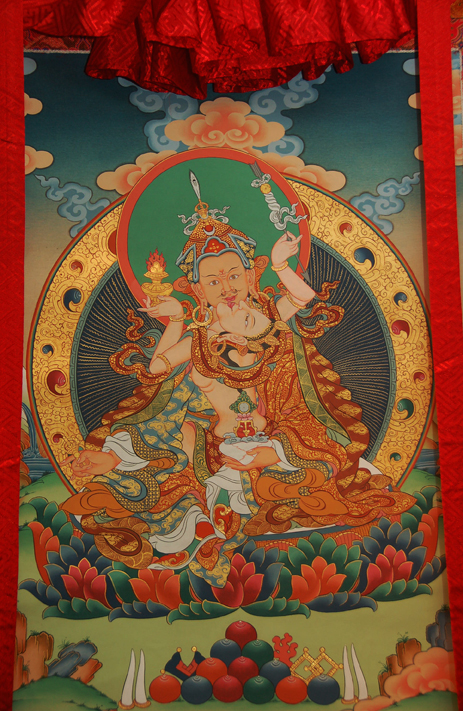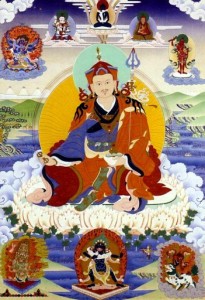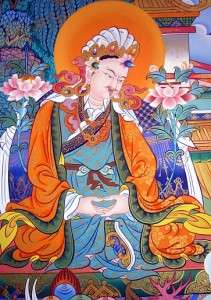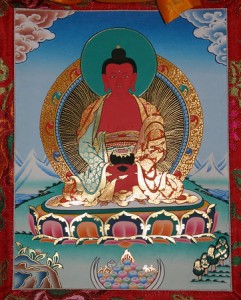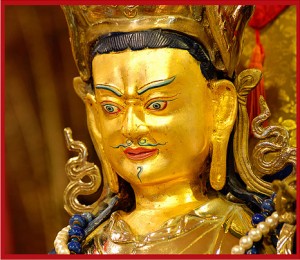Guru Rinpoche Thangka from Jetsunma’s home:
Guru Rinpoche
The Potent Nectar of the 7-Line Prayer: Full Length Video
The following is a full length video teaching offered by Jetsunma Ahkon Lhamo at Kunzang Palyul Choling:
The Seven-Line prayer is often called “the Kng of Prayers”. Through repetitio of this prayer many obstacles can be removed from your life, and your connection to your own spiritual nature is strengthened.
© copyright Jetsunma Ahkon Norbu Lhamo All rights reserved.
Prayer to Guru Rinpoche
The following prayer is from the Nam Cho Daily Practice Book by Palyul Ling International:
HRIH NGÖN GYI KAL PAI DANG PO LA
In the past, at the beginning of this aeon,
O GYEN YUL GYI NUB JYANG TSAM
In the northwest country of Uddiyana,
DHANA KO SHAI TSO LING DU
On an island in Lake Danakosha,
PEMA GESAR DONG PO LA
Born in the pollen heart of a lotus,
YA TSEN CHOG GI NGÖ DRUB NYE
Endowed with the most marvelous spiritual attainments,
PEMA JYUNG NE SHE SU DRAG
You are endowed as the “Lotus Born.”
KHOR DU KHANDRO MANG PÖ KHOR
Surrounded by a retinue of many Dakinis,
KHYED KYI JE SU DAG DRUB KYI
Following in your footsteps,
JYIN GYI LAB CHIR SHEG SU SOL
I pray to you: Please come forth and grant your blessings!
NE CHOG DI RU JYIN PHOB LA
Bestow blessings upon this supreme place of practice!
DRUB CHOG DAG LA WANG SHI KUR
Confer the four empowerments upon me, an excellent practitioner!
GEG DANG LOG DREN BAR CHED SOL
Dispel the obstacles arising from obstructing forces and misguiding spirits!
CHOG DANG THÜN MONG NGÖ DRUB TSOL
Please grant the common and supreme spiritual attainments!
OM AH HUNG BENZA GURU PEMA TÖTRENG TSAL BENZA SAMAYA DZA SIDDHI PHA LA HUNG AH
Canto 82: The Abolition of the Bon Rites by the King of Tibet
The following is an excerpt from “The Life and Liberation of Padmasambhava“:
…in the temple of Ãryapãla these were ordered to translate the Bon manuals of magic.
During the period, for royal sacrifice the Bon were required to provide a stag with antlers; they captured a stag alive and burst into song. Then they were told: “The gods’s share is needed.” They killed a sheep and a yak.
This impropriety and a number of others attracted the attention of the pandits and lotsawas to the behavior of the Bonpo.
Unanimously, but without prior arrangement, the pandits, and in order of rank, the lotsawas, turned to the king: “These Tibetan customs conflict with religious law. Since evil deviations demanding reprobation continue to be tolerated, we will return to our own countries.
Two masters are too many for one teaching,
two rights are too many for one liturgy,
two kings too many for one throne.
The friends of evil are not friends of truth.”
To this the king replied:
“When each denies the purity of the other, two religions are like two murders in confrontation.
But Buddhism is not widespread, and the Bon sect is powerful–several learned lotsawas already have had to be banished. If the two religions are allowed to spread, they will fuse into one.”
The pandits made no answer, but when they were asked to expound the Dharma, they did not do so.
While this was going on, Gyalway Lodro’s mother and minister of Tãranãga the Eminent died, and during the carrying out of the lustral ceremonies by the Bon and the Buddhist, the king came to believe more strongly in the Dharma and to doubt the Bon superstitions.
On the plain of Donkhar and oratorical joust was arranged, and the king to believe in the Dharma and to doubt the Bon superstitions.
Guru Padma and Tangnag the Bonpo faced one another, each in turn supporting and refuting every object of debate, and the king came to believe in the Dharma and to doubt the Bon superstitions.
The Bodhisattva, Śãntaraksita, and the leader of Shari faced one another, each in turn supporting and refuting every object of debate, and the king came to believe in the Dharma and to doubt the Bon superstitions.
Vimalamitra and Lishi of the Long Nape faced one another, each in turn supporting and refuting every object of debate, and the king came to believe in the Dharma and to doubt the Bon superstitions.
The nine Bon Vehicles and the nine of the Buddhadharma were confronted for their respective refutation by the lotsawas, and the king came to believe in the Dharma and to doubt the Bon superstition.
Go Beyond Safety to Live: Full Length Video Teaching
The following is a full length video teaching offered by Jetsunma Ahkon Lhamo at Kunzang Palyul Choling:
Using the example of Mandarava whose love for her Guru and the path was so strong that even a rock could not hold her from that – Jetsunma talks about the western belief that we should be in control at all times. This renders us unable to truly love. We will benefit from allowing that love and passion to be our guide.
Copyright © Jetsunma Ahkon Norbu Lhamo. All rights reserved
True Compassion
From The Spiritual Path: A Compilation of Teachings by Jetsunma Ahkon Lhamo
Dharmakaya is objectless compassion. It is everywhere. It upholds all manifested reality. All that we see, all appearances, are merely the arising of that mind in its emanation phase. Unfortunately, we have contrived a dualistic perception of self and other. We have acted against other. We have judged other. We have spent countless lives trying to earn the approval and love of other. While our true nature is untouched and perfectly pure, we have developed a dusty coating upon it. That coating is quite thick in the minds of sentient beings. Though their nature remains pure, their perception of that nature is not a true one. What we need is a way to see that true face. We need to discover firsthand the nature of non-dual mind, of that all-pervading compassion.
If this pure nature is the inner reality, then the appearance of Guru Rinpoche to the world is the outer reality. He is born from the heart of Amitabha Buddha, the face and name of the Dharmakaya itself. He entered into the world, a world that did not know Him, and a world that could not give Him birth. And yet He came. We are told that He was born upon a lotus. One way to understand this is to realize that such a pure and undefiled reality could not be born from the level of human delusion. Another way is to relate the lotus to your own mind. The lotus has its roots in mud and muck, yet appears on the surface as a pure, fresh, beautiful flower. Is that not like your own nature? Despite the mud and muck of eons of cyclic existence and the resulting delusion, that nature remains pure. It can still be born directly from the muck.
Upon that pure lotus appears Guru Rinpoche, just as within your own purified mind you realize the nature of the compassionate Guru. But in a mind polluted by judgment, stiffened by conceptualization, unstable through non-virtue, the Guru cannot be realized. He is born upon a pure lotus. Therefore, we make wishing prayers and do practices that we might finally see the Guru. If, without the purified mind, we cannot truly perceive the nature of the Guru, why did He come to a world unprepared for Him? Only a true understanding of all-pervading compassion can solve this mystery. Due to the Dharmakaya’s all-pervading, compassionate nature, it was possible for Guru Rinpoche to appear as a human and walk upon the earth while still purely displaying the uncontrived, fully realized nature of mind.
How was He received? How was He perceived by those around Him? Differently by each one. In the mind of delusion, it is possible to see the most precious gem as just another rhinestone. However, a few were able to perceive that this was beyond the ken of man and woman, that He was the precious Nature incarnate.
© Jetsunma Ahkön Lhamo
Self Conceit
The following is an excerpt from “Dakini Teachings: A Collection of Padmasambhava’s Advice to the Dakini Yeshe Tsogyal”
“Self Conceit:
Master Padma said: These so-called Dharma practitioners have great
ambition in their arrogance and self conceit.
The lady asked: What does that mean?
The master said: Some have self conceit regarding themselves as possessing knowledge in learning and teaching.
Some have self conceit regarding themselves as pious and practicing the Dharma.
Some have self conceit regarding themselves as meditators who live in the solitude of mountain dwellings.
Some have self conceit regarding themselves as powerful and as having great abilities.
Some yearn like a carnivorous animal smelling blood seeing wealth or a desirable object.
When seeing something that is undesirable or harmful, they run away like a wild yak set free.
They are fascinated by their own virtues as when they behold the eye of a peacock feather.
They envy the virtues of others like a watchdog guarding property.
In any case, these conceited Dharma practitioners are their own archenemy. I feel pity for such ignorant people who are in the grasp
of Mara.”
Guru Devotion
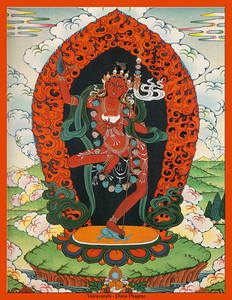
From The Spiritual Path: A Compilation of Teachings by Jetsunma Ahkon Lhamo
Is it just a coincidence that the one path that can bring about realization in a single lifetime is the one path that focuses upon the Guru as the ultimate object of refuge? No, for it is the astonishing potency of the Guru’s appearance in the world that makes this possible. Devotional yoga becomes everything: the milk, the nectar. There is no other practice. All else is but a part of that.
In Vajrayana, the Guru is the central figure, the supreme object of refuge. We rely on the Guru to ripen our minds, to bring our minds to fruition. But this is difficult for Westerners to accept. We Westerners are taught to be strong, independent individuals. This is all we have ever known. We are brought up to reach for things that are outside us, to collect them—and to be constantly self-concerned. Our generation is the first to swallow pop-psychology unquestioningly, even unconsciously. There are so many new-age ideas and so much misinformation mixed in with what passes for Dharma teaching and spirituality. This is made up by people who have not achieved enlightenment.
True enlightenment cannot be described. It is totally different from new age “aha!” insights. People go from teacher to teacher until they have collected a pocketful of something that they can paste on themselves. They fail to realize how materialistic and “collecting” they have been brought up to be. If you have always been on a merry-go-round, you will not know that you are going around in circles. You will fail to recognize the cultural-intellectual baggage that keeps you from deepening in your practice of Guru Yoga.
At first, this difficulty may appear to be an inherent lack of capacity in students. But when I look more closely, I see that the capacity is there. So, how do we break through? How can we turn our minds so that we form new habitual tendencies? Anything that arises from samsara, like our old habits, results in samsara. We can see this in our entire lives. We are not yet sitting on a lotus in the middle of a lake. How then are we supposed to practice Guru Yoga? What is our relationship with the actual Root Guru? How does this relationship take shape? Human beings, it seems, learn through suffering and through observation. Just as children need to mimic “grown-up-ness,” we need to see what Guru Yoga looks like in someone’s life. I shall try to describe this.
First, if you have the good fortune to meet your Root Guru, and if you make a commitment in your mind, heart, and prayers or to the face of this Guru, you must never—even at the cost of your life—break that commitment. At first, make only commitments that you can work toward and keep. In the context of your Guru Yoga, a perfect preliminary level of commitment to your Teacher would be: “I will do more than I have ever done before, and I will continually deepen my devotion and practice.” Then as you grow on the path, you keep increasing your commitment. Some of my students have made flowery, dramatic commitments to me and then broken them as if they were merely hot air. Without exception, those are students who have become stagnant in their practice.
This is from my heart to your heart. When you make a commitment to your Root Guru, you must understand what you are doing: You are making a commitment to the condensed essence of all the objects of refuge, to all the Lamas, not just the one Lama, to all the Buddhas, to all the Bodhisattvas, to all the meditational Deities, to all the Dakinis, to all the Dharma Protectors. Moreover, you are making that commitment to the very door of liberation itself. Consider once again what the Teacher actually is for you. Remember that sentient beings are wandering helplessly in samsara—afraid, alone, and without hope. It is like being in a burning room with no way out. Nothing in samsara can help you to escape. Only the objects of refuge—all contained in the vessel that is the Root Guru—can provide an exit. The heat keeps increasing, and your body is fragile. The Lama is the way out, the door to liberation. Picture yourself in a burning room. Would you have difficulty concentrating on the door? I doubt it.
But again, if you are a “collecting” materialist, if you keep the greater portion of everything for yourself, for your own happiness, if you remain as the center of the mandala of your life, you cannot walk through that door. The Lama must be at the center of your mandala. Is that schizophrenic? Is it psychotic? Will you go mad? How can someone else be at the center of your spiritual focus?
When you practice Guru Yoga correctly, you are practicing view. You gradually come to understand that upon recognizing the Lama, upon becoming non-dual with the Lama, you recognize your own true nature, your own true face, that which is beyond accepting and rejecting. If the Lama is in the center of the mandala of your practice, you are training yourself to awaken, to exit samsara, to achieve realization for the sake of sentient beings. But if you break the connection with your Root Guru, you cannot accomplish Dharma. No matter what happens, once you have made the offering of body, speech and mind to the spiritual friend who has hooked and established you on the path, to the Root Guru, you must never abandon that commitment. If you do, you are cutting off the very root and source of your accomplishment. After that there is no real accomplishment on the path, no matter what you do. You must always keep your view pure, and therefore the Guru Yoga will be your blessing and your true spiritual wealth. So even if you are on the other side of the planet, the Root Guru should rest upon your heart or above the crown of your head when you say your prayers. Never break that connection, even for a moment.
You should guard your commitment, thinking of yourself as Dorje Phagmo with fangs, as though you had fangs or weapons. Anything that prevents you from relying completely on your Root Guru should be cut away from your heart, cut out of your life. It’s as if you have fangs coming out, and that curved vajra blade in your hand, and you’re swinging at anything that comes near this connection. You’re guarding your own personal treasure, not allowing a single bit of impurity to be near it. Those fangs should always be out.
© Jetsunma Ahkön Lhamo
